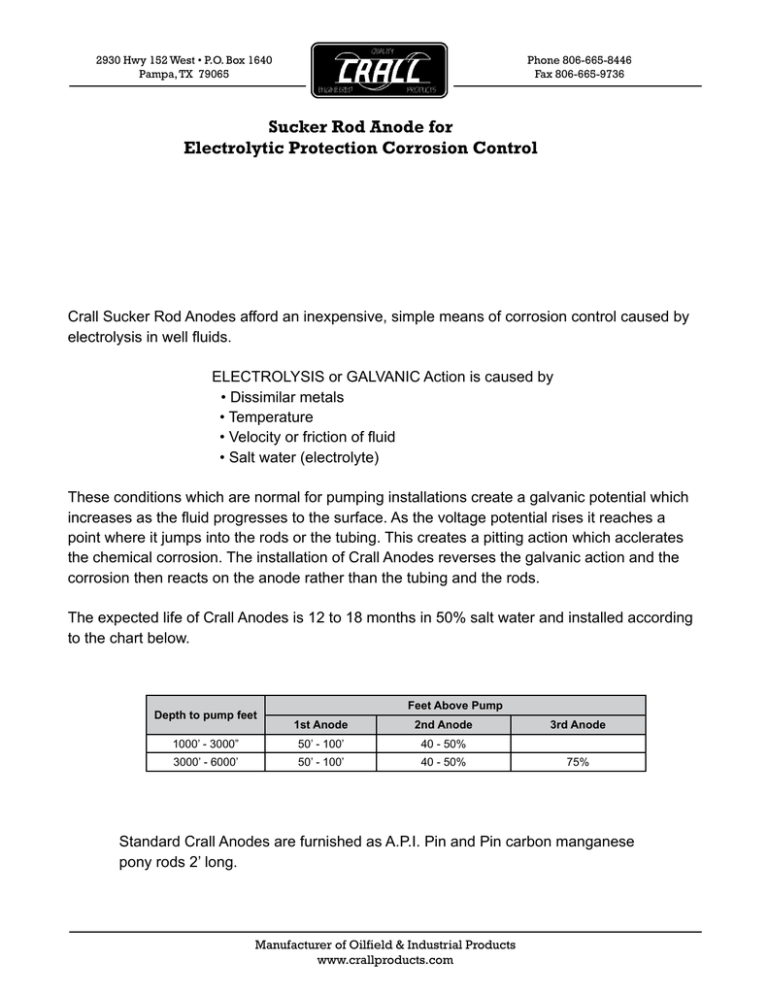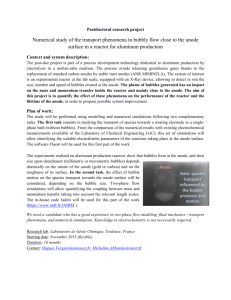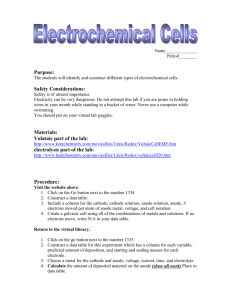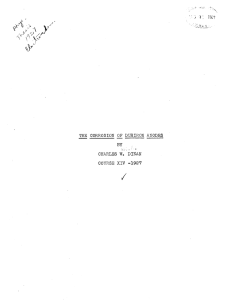Sucker Rod Anode for Electrolytic Protection Corrosion Control
advertisement

2930 Hwy 152 West • P.O. Box 1640 Pampa, TX 79065 Phone 806-665-8446 Fax 806-665-9736 Sucker Rod Anode for Electrolytic Protection Corrosion Control Crall Sucker Rod Anodes afford an inexpensive, simple means of corrosion control caused by electrolysis in well fluids. ELECTROLYSIS or Galvanic Action is caused by • Dissimilar metals • Temperature • Velocity or friction of fluid • Salt water (electrolyte) These conditions which are normal for pumping installations create a galvanic potential which increases as the fluid progresses to the surface. As the voltage potential rises it reaches a point where it jumps into the rods or the tubing. This creates a pitting action which acclerates the chemical corrosion. The installation of Crall Anodes reverses the galvanic action and the corrosion then reacts on the anode rather than the tubing and the rods. The expected life of Crall Anodes is 12 to 18 months in 50% salt water and installed according to the chart below. Depth to pump feet Feet Above Pump 1st Anode 2nd Anode 1000’ - 3000” 50’ - 100’ 40 - 50% 3000’ - 6000’ 50’ - 100’ 40 - 50% 3rd Anode 75% Standard Crall Anodes are furnished as A.P.I. Pin and Pin carbon manganese pony rods 2’ long. Manufacturer of Oilfield & Industrial Products www.crallproducts.com 2930 Hwy 152 West • P.O. Box 1640 Pampa, TX 79065 Phone 806-665-8446 Fax 806-665-9736 Sucker Rod Anode Technical Data for Electrolytic Protection Corrosion Control Control of electrochemical corrosion often referred to as Electrolysis or Galvanic Action occurs by chemical (rusting or oxidation) or by electrochemical attack in down-hole oil well equipment. In the chemical attack of the metal there is no appreciable flow of electrical current in the well bore; while in the electrochemical system there is a significant, if small, current flow. Electrochemical corrosion is often exhibited as the rapid and premature pitting and erosion of sucker rods, tubing and bottom hole pump in an oil well. The introduction of zinc, aluminum or magnesium, properly maintained and located, in the well bore, provides a direct and effective meanbs of controlling electrochemical corrosion on these vital metal parts. In almost every oil well pumping operation there is the presence of some water in the produced fluid. Occurring also in oil field waters are CO2 (carbon dioxide); NaCL (salt); CaSO4 (calcium sulphate): and H2S (hydrogen sulfide) which makes the waters a good electrolyte or electrical conductor. Basically, the down-hole equipment, pump, rods and tubing acts as the lates of a battery cell; while the fluid acts as the electrolyte. If the metals are dissimilar, such as zinc and steel, this is referred to as a galvanic cell. If the metals are similar they are referred to as a concentration cell. In either instance, however, there must be a small current flow between the metal parts for a cell action to take place. Electrochemical corrosion occurs on metal parts when the direction of the current flow in the electrolyte is out of the surface of the metal and into another metal part. In effect it has become the anode or positive pole in a battery circuit while the metal the current is flowing into has become the cathode or negative pole. As an example, a galvanic cell is shown in Figure 1. A strip of zinc and steel are immersed in a solution of ferrous chloride. The electrons, e, flow from the anode, A, to the cathode, C, through the wire and lights the bulb. The zinc anode is attacked and corroded in this cell while the Fe (steel cathode) is protected. Electrochemical corrosion has taken place on the steel strip. In this cell reaction the zinc strip became the anode because of its higher position on the activity series as compared with the steel. If aluminum or magnesium replaced the zinc in an electrolyte they would become the anodes for the same reason. Manufacturer of Oilfield & Industrial Products www.crallproducts.com 2930 Hwy 152 West • P.O. Box 1640 Pampa, TX 79065 Phone 806-665-8446 Fax 806-665-9736 Sucker Rod Anode Technical Data for Electrolytic Protection Corrosion Control In Figure 2 the bottom hole equipment of a well is schematically shown. The arrows reveal the direction of the current flow in the cell reaction. Since the current flow is out of the tubing, rods and pump, they are being attacked by electrochemical corrosion. In Figure 3 the Crall anode is added to the rod string and becomes the new positive pole for cell action. The direction of current flow, as indicated by the arrows, has been reversed and is now flowing into the tubing, rods and pump. The Crall anode has protected the metal parts by feeding the electrochemical reaction. Since the Crall anode is being sacrificed to protect the more expensive down hole parts, it will require periodic replacement. The period of replacement will be determined by the severity of the electrochemical corrosion problem in a particular application. Zinc, aluminum or magnesium work very well for anode material. However, due to high chemical activity of aluminum and magnesium, zinc is a more desirable material for down-hole applications and for that reason Crall anodes are all zinc. Due to the wide variations of down-hole conditions in oilwells Table 1 shows a g eneral approximation based on years of experience and will apply to most installations. The expected life of Crall anodes is 12 to 18 months in 50% salt water and installed according to Table 1. Depth to pump feet Feet Above Pump 1st Anode 2nd Anode 1000’ - 3000” 50’ - 100’ 40 - 50% 3000’ - 6000’ 50’ - 100’ 40 - 50% 3rd Anode 75% Standard Crall anodes are furnished as A.P.I. Pin and Pin carbon manganese pony rods 2 feet long in 1/2”, 5/8”, 3/4”, 7/8” and 1”. Any other type, grade and/or specific manufacturer of pony rods can be furnished on request. Manufacturer of Oilfield & Industrial Products www.crallproducts.com







